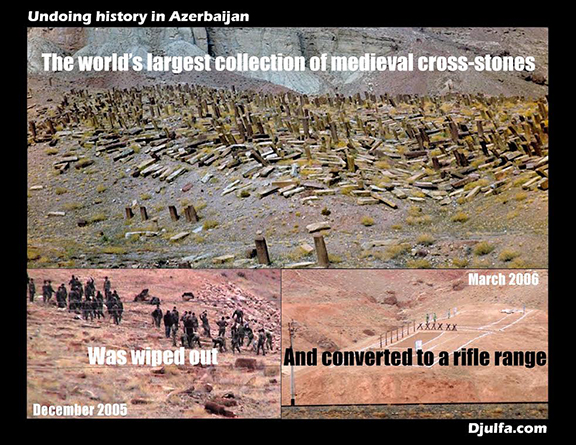YEREVAN (Tert.am)—Ten years ago today, the Azerbaijani authorities destroyed the Armenian Cemetery of Djulfa and began the demolition of several Armenian monuments in Nakhichevan.
In the unprecedented act of vandalism, thousands of Armenian khachkars (cross-stones) were leveled down with the help of heavy equipment. The desecration of the monuments began back in 2003 and carried on until 2006.
Samvel Karapetyan, a monument expert studying samples of Armenian architecture in and outside of Armenia, described Azerbaijan’s vandalism as an act encouraged by Turkey, the country traditionally considered its more powerful brother.
“The ancient site of international significance does not exist for ten years, so we are not able to do anything to return [it]. But we can, of course, raise the world’s awareness of the crime committed. To rule out such brutalities, that country must be condemned and punished. Otherwise, such incidents will always repeat themselves. And they do; while we are talking now, the Azerbaijanis are destroying [more monuments]. That’s also because their ‘elder brother’, Turkey, wasn’t punished for that.”
Azerbaijan’s vandalism received an international reaction by institutions such as the European Commission, the Parliamentary Assembly of the Council of Europe (PACE), the Holy See of Vatican and the Greek Orthodox Church’s Synod, and even the International Council on Monuments and Sites (ICOMOS). World-renowned scholars and politicians also voiced their criticism over the act of desecration.
On February 16, 2006 the European Parliament adopted a resolution condemning the destruction of the medieval cemetery in Djulfa and the historical monuments in Nakhichevan. The European Parliament also demanded that Parliament representatives be allowed to visit these destroyed sites.
Inquiries regarding this issue are discussed at almost every session with PACE. A European parliamentarian has once even proposed organizing a visit to Djulfa, but Azerbaijan strongly rejected the idea.
[youtube https://www.youtube.com/watch?v=JZu2zqFE_gI?feature=oembed&w=640&h=480]
Naira Zohrabyan, a member of the Armenian delegation to PACE, recalled the screening of the movie “20th Century Vandals” at a joint session of the EU-Armenia Parliamentary Cooperation Committee. The Armenian parliamentarian, who then headed the Committee, remembered the strong reaction to the movie.
“And it was unprecedented, as we managed to break the Azerbaijani lobbyist resistance to organizing the screening. Of course, numerous notes of protest by the Azerbaijani Foreign Ministry followed, but we believe we did manage to attract European organizations’ attention to the problem,” she noted.
Different international scholars, joined by US senators, co-signed a letter to UNESCO and other international bodies, condemning Azerbaijan’s aggression. Mikhail Borisovich Piotrovsky, the director of the Hermitage Museum in Saint Petersburg, described the violence as an act of crime. A British member of the European Parliament, Charles Tennock, compared it with Taliban’s move to destroy the monument of Buddah.
Adam Smith, an anthropology professor at the Chicago University, condemned the vandalism as “a shameful episode in humanity’s relation to its past, a deplorable act on the part of the government of Azerbaijan which requires both explanation and repair.”
In 2010, a cross-stone park with 20 replicas of the vandalized khachkars opened near the Church of Holy Savior of All in Gyumri, Armenia’s second largest city.
Source: Asbarez
Link: Today Marks 10 Years Since Azerbaijan’s Demolition of the Armenian Cemetery of Djulfa

